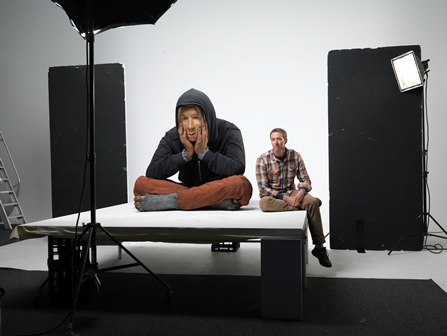Paul Trefry with one of his creations.
CreatureNFX’s Paul Trefry studied graphic design at Randwick TAFE in 1984. After graduating the next year, he admits he had “no idea what to do”.
During the course he had already demonstrated a knack for making things with his hands, a skill which won him his first gig.
“At the end of second year we were given particular projects to do during the course, and instead of drawing them I’d physically make things,” says Trefry.
“And then a guy in the year before me who had gotten a job at an advertising agency wanted a little diorama made and asked me to do it.”
Upon graduation, Trefry travelled to the UK and spent time with the Jim Henson Company, shortly after the company had finished work on Labyrinth. “I thought yeah, this is the direction I want to go in.”
Returning to Australia, he was hired as a model maker by a company in Sydney before leaving, a year later, to start his own company – “and I’ve been doing it ever since.”
One of Trefry's most recent gigs was on Ridley Scott’s Alien: Covenant, which wrapped in Sydney last year. Trefry was brought on by Odd Studio and and the UK's Creatures Inc to do some sculpting.
“It was good fun," says Trefry. "Ridley’s really good to work with. Quirky but good. With the decades of experience he’s got, he knows what works and doesn’t work. He knows exactly what he wants – and exactly how we can do it. He’s really good at methodology. I’m assuming [that’s] because he’s worked with so many people doing creatures.”
“His reference illustrations are awesome, because he can draw; he has an arts background. A lot of directors can’t; they can tell you what they want but they can’t physically give you the visual information.”
Trefry describes tinkering away on “lots of bodies and little critters”.
“The main guy was a hybrid between a suit and an animatronic. There were quite a few suits, and then the headpiece is obviously an animatronic because you can’t operate it by hand.”
The demand for physical builds is getting “smaller and smaller,” says Trefry, “because digital’s really popular.”
“Digital’s a great tool, [but] it’s sterile, and if you talk to any talent, it’s hideous working with a green screen, because you’ve got a tracking ball on the end of a stick. You get an eyeline, great, but they’ve got nothing to play off.”
Trefry is hopeful the tide might be turning.
“Everything’s cyclical. We’ve gone through a very digital heavy period in film, [but] I think with Star Wars they’re swaying back to practical, because it does have a soul and a presence and you know what you’re getting in camera straight away.”


